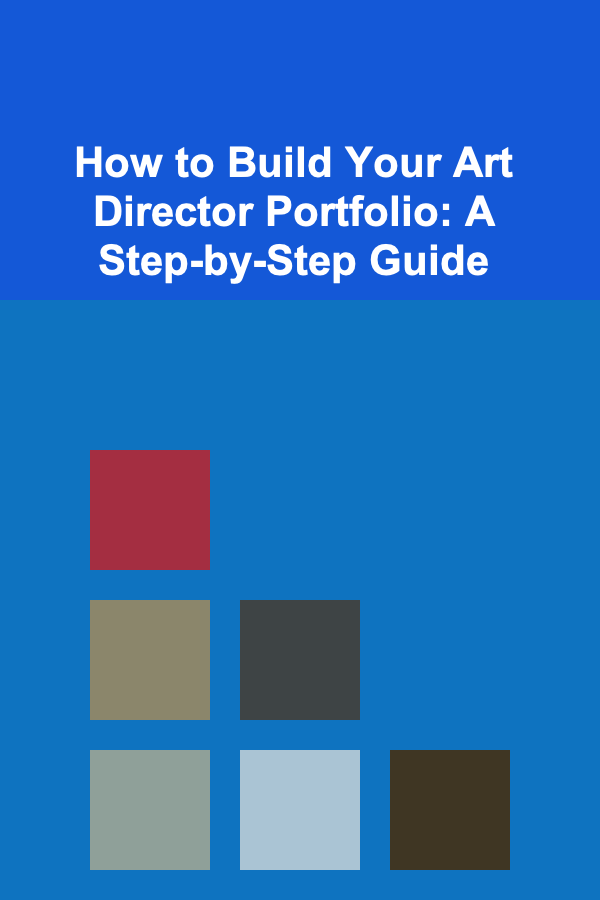
How to Build Your Art Director Portfolio: A Step-by-Step Guide
ebook include PDF & Audio bundle (Micro Guide)
$12.99$6.99
Limited Time Offer! Order within the next:

Building a strong portfolio is one of the most critical steps in establishing yourself as a successful art director. Your portfolio is not just a collection of your best work---it's a visual narrative that demonstrates your skills, creative process, and ability to solve design problems for various clients. In the highly competitive field of art direction, an effective portfolio can set you apart from the crowd and open the door to exciting career opportunities.
This step-by-step guide will take you through the process of building a standout art director portfolio that showcases your abilities, communicates your design sensibility, and positions you as a professional in the creative industry.
Step 1: Understand What Makes a Strong Art Director Portfolio
Before you begin building your portfolio, it's essential to understand what makes an art director's portfolio effective. Unlike a graphic designer's portfolio, an art director's portfolio must showcase leadership, conceptual thinking, and the ability to oversee and execute visual concepts across multiple mediums.
Here's what an art director's portfolio should demonstrate:
- Creative Direction: Your ability to lead a creative project and make high-level decisions about visuals, layout, and aesthetic style.
- Design Execution: Showcasing your skills in typography, layout, color theory, and visual storytelling.
- Problem Solving: How well you approach and solve design challenges for different types of clients and industries.
- Collaboration: Experience working with designers, copywriters, photographers, illustrators, and other professionals in the creative process.
- Versatility: The ability to work across different mediums and platforms, such as print, digital, and social media, demonstrating your adaptability and wide-ranging skills.
In short, your portfolio should tell the story of how you think, create, and collaborate. It's about showcasing not just your design work but your approach to visual storytelling and art direction.
Step 2: Curate Your Best Work
Building your portfolio is not about showing every piece you've ever created. Instead, it's about carefully curating the best projects that align with your skills as an art director. Start by reviewing your past work and selecting projects that represent your range, creative vision, and experience.
Here are some tips for curating your portfolio:
Choose Projects that Showcase Your Leadership
As an art director, your role is often to oversee the visual direction of a project, from concept to execution. Be sure to highlight projects where you had a leadership role. For example, projects where you led a team of designers, worked directly with clients, or managed the visual concept for a campaign or brand.
Select Work Across Different Media
Your portfolio should demonstrate your versatility as an art director. Choose projects that showcase your ability to work in different media, such as:
- Print: Brochures, posters, flyers, editorial design, etc.
- Digital: Website design, mobile apps, social media content, digital advertising, etc.
- Branding: Logos, brand guidelines, packaging, and visual identity systems.
- Photography/Illustration: Any collaborations or creative direction in visual content creation.
Having a range of work across different platforms allows potential employers or clients to see that you can handle diverse creative challenges.
Show Your Best Work, Not Your Entire Work
It's crucial to only show your strongest and most relevant work. A few high-quality projects will speak volumes more than an overwhelming amount of mediocre work. Choose pieces that reflect your strengths as an art director and align with the kind of work you want to be hired for.
Include Case Studies
Whenever possible, include detailed case studies of your work. A case study allows you to show the entire process behind a project, from concept to final execution. Include key elements like:
- Project Brief: Explain the challenges the client or project presented.
- Creative Process: Share your thought process, from brainstorming to developing the initial concept.
- Collaboration: Showcase how you worked with other creatives, such as designers, copywriters, or photographers.
- Final Outcome: Show the finished product with high-quality images, and explain how it solved the client's needs.
By including case studies, you provide potential clients or employers with a deeper understanding of your approach and problem-solving skills.
Step 3: Showcase Your Design Process
As an art director, it's essential to showcase your design process rather than just the final results. A good art director is someone who can think strategically and develop ideas that align with a brand's goals and target audience.
Start with Conceptual Work
For each project, include early concept sketches, mood boards, or rough drafts that show your initial thought process. These artifacts demonstrate your ability to think creatively and explore different directions before arriving at the final design.
Document Revisions and Feedback
Include examples of how you incorporated feedback or made revisions throughout the project. This can show how you handle client requests, collaborate with teams, and adapt your designs to meet various needs and challenges.
Highlight Collaboration and Teamwork
Art direction often involves working closely with other creatives, including graphic designers, photographers, illustrators, and copywriters. Show how you led or collaborated with other team members to bring the project to life. You can include photos of behind-the-scenes work or snippets of collaborative processes to highlight your leadership and teamwork skills.
Step 4: Design Your Portfolio
Now that you have curated your best work, it's time to design your portfolio. Your portfolio should reflect your skills and style as an art director, while also being functional and easy to navigate. It's important to create a user-friendly experience that guides viewers through your work seamlessly.
Choose the Right Platform
There are several ways to present your portfolio, from physical books to digital platforms. The most common way to showcase your work today is through a digital portfolio. This could be a personal website or an online platform like Behance, Dribbble, or Adobe Portfolio.
- Personal Website: A self-hosted website gives you complete control over your portfolio's design and content. It also offers more flexibility in terms of customization and branding.
- Portfolio Websites: Platforms like Behance and Dribbble are great for building a professional online portfolio and connecting with other creatives. However, they come with limited design options compared to a personal website.
Regardless of which platform you choose, ensure that your portfolio is easily accessible, mobile-friendly, and professional.
Keep It Simple and Clean
Your portfolio should not be overloaded with design elements. The focus should be on your work, not on flashy animations or overly complicated navigation. Keep the design simple and clean, with clear typography and ample white space to allow your projects to shine. Make sure to include the following sections:
- Home: A brief introduction about you and your approach to art direction.
- Portfolio: A gallery of your best work, categorized by project type (e.g., print, digital, branding).
- About: A short biography that highlights your background, experience, and design philosophy.
- Contact: Clear contact information and a way for potential clients or employers to get in touch.
High-Quality Images
The visual quality of your work is everything. Ensure that your portfolio features high-quality images of your designs. Avoid pixelated images, and try to capture your designs in context (e.g., mockups of websites, branded materials, or packaging) to give them a realistic and professional appearance.
Consistency in Presentation
Whether you're presenting physical mockups or a digital portfolio, consistency is key. Use the same font, color palette, and layout throughout your portfolio to ensure it looks polished and cohesive. This is a reflection of your attention to detail and design sensibility.
Step 5: Update Your Portfolio Regularly
Your portfolio is not a static document. As you continue working and gaining new experiences, you should update your portfolio regularly to include new projects and remove outdated ones. Keeping your portfolio fresh is essential for staying relevant and competitive in the industry.
- Review Your Work: Periodically assess your portfolio to ensure it reflects the work you want to be known for. Remove any projects that no longer align with your current skill set or career goals.
- Add New Work: Always add new projects that showcase your growth and evolution as an art director. Even if you're not working on large-scale projects, adding smaller freelance work, personal projects, or collaborations can help keep your portfolio dynamic.
Step 6: Seek Feedback and Iterate
Before sharing your portfolio with potential employers or clients, seek feedback from trusted peers, mentors, or colleagues. Constructive criticism can help you refine your presentation, clarify your messaging, and ensure your portfolio communicates the right message.
Once you've received feedback, don't hesitate to make adjustments. Iterate on your portfolio to make sure it showcases your skills and creative vision in the best possible way.
Conclusion
Building a standout art director portfolio takes time, effort, and a clear strategy. It's not just about showing your best work---it's about presenting a cohesive narrative of your creative journey, design thinking, and leadership capabilities. By carefully curating your projects, showcasing your process, and designing your portfolio with care, you can create an effective tool to help you stand out in the competitive world of art direction.
Remember, your portfolio is a living, breathing document that should evolve with your career. Stay true to your design sensibility, keep it fresh, and let it be a testament to your skills, creativity, and growth as an art director.
Reading More From Our Other Websites
- [Home Pet Care 101] The Best Plants for a Pet-Friendly Home
- [Home Party Planning 101] How to Create an Inviting Atmosphere with Party Lighting
- [Home Pet Care 101] Why Spaying and Neutering Your Pet is Important
- [Personal Investment 101] How to Use Deep Learning to Build Recurring Revenue Streams
- [Hiking with Kids Tip 101] How to Set Up a Picnic Rest Spot on the Trail That Keeps Young Children Engaged and Safe
- [Home Renovating 101] How to Choose the Right Countertops for Your Renovated Kitchen
- [Home Family Activity 101] How to Make a Family Puzzle Night with Custom Puzzles
- [Home Rental Property 101] How to Convert Your Home into a Vacation Rental Property
- [Simple Life Tip 101] Best Simple‑Living Fitness Routines You Can Do Anywhere, Anytime
- [Organization Tip 101] How to Maximize Space in Small Dorm Rooms for School Supplies

10 Simple Strategies for Saving Money on Groceries Every Week
Read More
How to Decorate Your Home with Inexpensive Throw Pillows and Blankets
Read More
How to Identify High-Growth Investment Opportunities
Read More
How to Use a Weekly Planner for Household Management
Read More
How to Use High-Speed Sync Flash
Read More
Calculating Your Home's Energy Needs for Renewables: A Comprehensive Guide
Read MoreOther Products

10 Simple Strategies for Saving Money on Groceries Every Week
Read More
How to Decorate Your Home with Inexpensive Throw Pillows and Blankets
Read More
How to Identify High-Growth Investment Opportunities
Read More
How to Use a Weekly Planner for Household Management
Read More
How to Use High-Speed Sync Flash
Read More